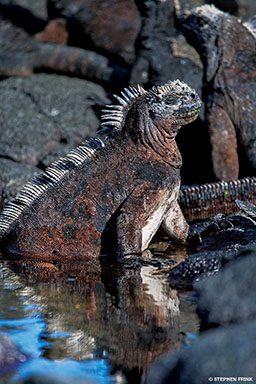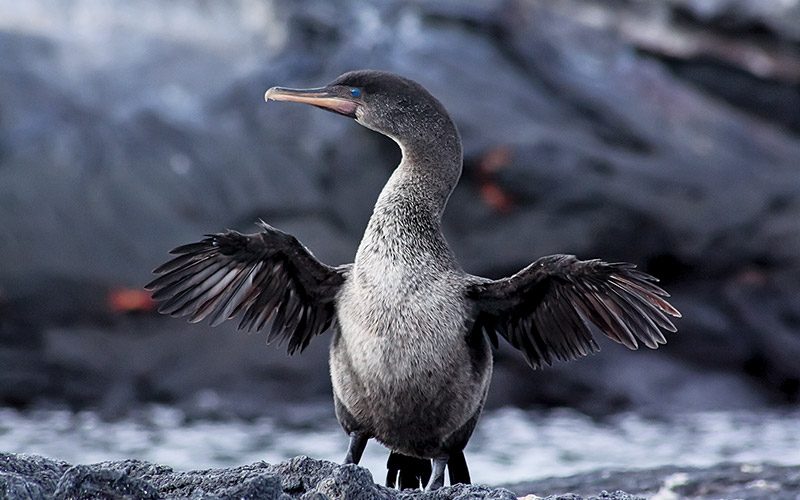Underwater in the Galapagos Islands the sights are magnificent. King angelfish hover over large green sea turtles; algae on the turtles’ shells attract the fish like bees to honey. Large colorful parrotfish graze amid roaming schools of surgeonfish. Spotted eagle rays swim gracefully beside walls of coral and volcanic rock, while whitetip sharks lazily cruise by. In an archipelago that straddles the equator, these species are not unexpected. But then something strange occurs: A small black and white missile rockets past, leaving only bubbles in its wake. A penguin? Penguins living side-by-side with tropical fish and coral?
The Galapagos Islands host one of the strangest collections of animals in the world. Here marine organisms that we normally think of as warm-water species coexist with colder-water inhabitants. The confluence of ocean currents, the remote nature of the islands and adaptations over time have given rise to an abundance of species that are found nowhere else.

Known as “the enchanted islands,” the Galapagos are located some 600 miles west of Ecuador. The equatorial latitudes provide conditions suitable for tropical fauna such as coral, colorful fish, sea turtles, eagle rays and warm-water sharks. But the islands’ waters also host colder-water species such as sea lions and penguins. The only penguin found north of the equator, Galapagos penguins are relatively small, averaging about 19 inches in height. They are extremely cute and exceptionally fast underwater (and sneaky when you are trying to photograph them). Among the ocean currents that influence the islands’ ecology are the Humboldt (or Peru) Current, the Panama Current, the North Equatorial Current, the South Equatorial Current and the Cromwell Current (or Pacific Equatorial Undercurrent).
These ocean currents along with the prevailing winds provide arrival routes for flora and fauna; they are also responsible for the archipelago’s seasons. From about June to November, the southeast trade winds prevail, and the Humboldt Current, originating in the south from Antarctica and Chile, brings cool air and cold, nutrient-rich water to the Galapagos. This is the dry or garúa (Spanish for “mist”) season. The cool air creates an inversion layer, and only the higher elevations receive significant rain, though a mist or fine drizzle often occurs in the lowlands and over the sea. The water is noticeably colder, the winds are stronger, and productivity increases throughout the islands. Whales such as humpbacks, Bryde’s, minkes and even enormous blues may be present this time of the year.
From about December to May, the southeast trade winds abate, allowing the northeast trade winds and the warm, southward-flowing Panama Current to predominate. This is the hot, wet season in the Galapagos. Rain is more common, the winds diminish, and when clouds are absent or few, the sun’s rays are intense. Surface waters are warm, but a sharp thermocline typically remains, and at depth the water quickly brings on a chill. This is especially true in the western islands, Isabela and Fernandina, where the eastward-flowing Cromwell Current strikes the islands at depth and upwells, bringing cold, nutrient-rich waters to the surface year-round. This is why marine life is especially abundant and often larger in the western part of the Galapagos. The rich oceanic food web in the region supports the largest marine iguanas in the Galapagos (they can be more than 4 feet long), and plentiful seabirds such as flightless cormorants, penguins and blue-footed boobies. Manta rays and whales, including a resident pod of orcas, are also more likely to be found in the western Galapagos.

The ocean currents also help explain the origins of many Galapagos species. Animals that floated in on currents, perhaps aboard rafts of vegetation, may have initially found little competition and abundant food. With the arrival of additional individuals, species then reproduced and became established. Over time and in isolation, these animals adapted to conditions in the Galapagos and evolved.
Two examples provide perhaps the most obvious and dramatic illustrations of this adaptation and evolution. Elsewhere in the world, cormorants are flying birds that dive for food and nest in trees. In the Galapagos, cormorants have only small vestiges of their original wings left. Known as flightless cormorants, these birds have lost the ability to fly; they build their nests on the rocky shore very close to the sea. Their legs are thicker and stronger than those of other cormorants — perfect for swimming and hopping around on land. Flightless cormorants’ small scraggly wings seem to be used mainly for balance as they move about the rocky coastline. After their arrival and establishment, with little competition, few predators and plentiful food, there was no need for cormorants to travel between feeding and nesting sites, so over time the birds simply lost the ability to fly.

Marine iguanas are possibly the most bizarre and fascinating endemic species in the Galapagos. Primitive and darkly fierce-looking, they resemble something out of Jurassic World. But marine iguanas are docile ectothermic creatures that spend much of their time lying on the rocky shore to get warm. They do this to increase their body temperature after dives into the cold ocean to feed on algae. Marine iguanas reportedly can stay underwater for up to 45 minutes. There are few things stranger than seeing a marine iguana sitting on the seafloor munching away. To rid their bodies of excess salt consumed while eating algae, marine iguanas frequently sneeze it out their nose. Land iguanas are abundant on some of the islands in the Galapagos. Presumably, competition for food and/or territory is what first drove land iguanas to the sea for food and led to the evolution of a new marine species.
Other endemic marine species include the Galapagos penguin, Galapagos shark, Galapagos sea lion, Galapagos fur seal and the salema, which is a small striped fish often found here in dense schools.

The islands’ ecosystem is strongly governed by resource availability. When productivity in the ocean is high, life flourishes on land and in the sea. When resources become scarce, populations plummet. During strong El Niños, warm water typically flows eastward along the equator. The islands of the Galapagos are bathed in unusually warm water, and upwelling is shut down by strong stratification. Marine biologist Peter Glynn and his colleagues found that because corals are acclimated to relatively colder water temperatures in the Galapagos, up to 95 percent have perished in previous strong El Niños. Populations of penguins, marine iguanas, sea lions and seabirds also suffer significant mortalities when productivity diminishes. Some experts are predicting a strong El Niño for the second half of 2015, so researchers are closely monitoring water temperature and populations.
Diving or snorkeling in the Galapagos is a rare treat. After years of protected status, many of the islands’ creatures have acclimated to human presence. Rolling with playful sea lion pups or being surrounded by unperturbed sea turtles is simply magical. Rays and fish swim close by, and schools of hammerheads often encircle divers for curious perusal. And when a penguin rockets by or feeds in a nearby baitball, it is nothing short of astonishing.
Although animals are protected on land and in the sea, illegal fishing and poaching is a serious issue. The Galapagos National Park directorate strictly regulates tourism in the archipelago, and a licensed Galapagos National Park naturalist guide must accompany all visitors. The system appears to be working, and for now the islands remain a wondrous adventure for nature lovers. I treasure every opportunity to experience the Galapagos and recommend it as a diving, snorkeling and hiking adventure for all.
Explore More
Watch the clip “Sneezing Marine Iguanas” from BBC Earth.
© Alert Diver — Q4 Fall 2015